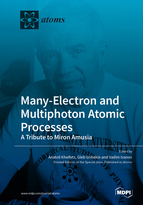Many-Electron and Multiphoton Atomic Processes: A Tribute to Miron Amusia
A special issue of Atoms (ISSN 2218-2004).
Deadline for manuscript submissions: closed (1 September 2022) | Viewed by 38367
Special Issue Editors
Interests: theoretical atomic and condensed matter physics
Interests: many-body theory in atom; electron-atom scattering, negative ions, photodetachmen, multiphoton processes in strong laser fields
Special Issue Information
Dear Colleagues,
This Special Issue will contain contributions from numerous colleagues and collaborators of the late Prof. Miron Amusia, who had been a key figure in the international theoretical atomic physics community over the past half a century. The focus of the Special Issue will be on many-electron and multiphoton atomic processes which are at the forefront of contemporary atomic and molecular physics. Special attention will be given to many-electron correlation problems and its interplay with strong-field laser–atom interactions. Recent advances in the generation of short and intense laser pulses make this problem particularly topical. Although some recent topical issues have addressed strong laser physics and attosecond science (MDPI Applied Sciences 2019, IOP J.Phys & J.Photonics 2020), the many-electron correlation problem has never been the focus in this context. Therefore, the present proposal will usefully supplement existing literature and will be of interest to a large section of the atomic and strong laser physics community, both theoretically and experimentally.
Prof. Dr. Anatoli Kheifets
Dr. Gleb Gribakin
Prof. Dr. Vadim Ivanov
Guest Editors
Manuscript Submission Information
Manuscripts should be submitted online at www.mdpi.com by registering and logging in to this website. Once you are registered, click here to go to the submission form. Manuscripts can be submitted until the deadline. All papers will be peer-reviewed. Accepted papers will be published continuously in the journal (as soon as accepted) and will be listed together on the special issue website. Research articles, review articles as well as short communications are invited. For planned papers, a title and short abstract (about 100 words) can be sent to the Editorial Office for announcement on this website.
Submitted manuscripts should not have been published previously, nor be under consideration for publication elsewhere (except conference proceedings papers). All manuscripts are thoroughly refereed through a single-blind peer-review process. A guide for authors and other relevant information for submission of manuscripts is available on the Instructions for Authors page. Atoms is an international peer-reviewed open access quarterly journal published by MDPI.
Please visit the Instructions for Authors page before submitting a manuscript. The Article Processing Charge (APC) for publication in this special issue is free of charge. Submitted papers should be well formatted and use good English. Authors may use MDPI's English editing service prior to publication or during author revisions.
Keywords
- theoretical atomic and molecular physics
- electronic structure of atoms and molecules
- many-electron correlation
- strong laser–atom interaction
- attosecond science
- high-order harmonic generation
- tunneling and multi-photon ionization
- electron scattering from atoms and molecules
- endohedral atoms








